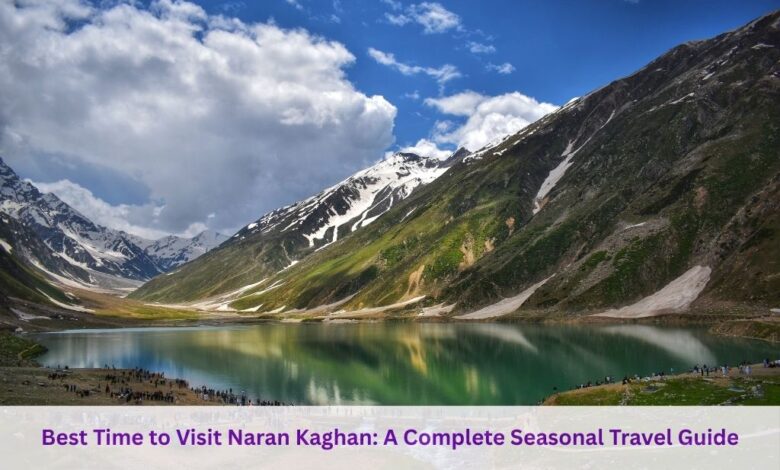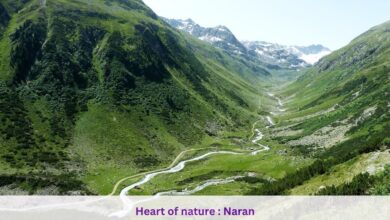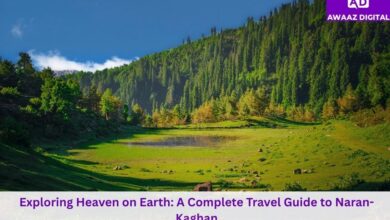
Two of the most gorgeous valleys in Pakistan, Naran and Kaghan a tucked away in the Khyber Pakhtunkhwa province. The valleys are indeed heaven with snow-capped mountains, gleaming rivers, rich green meadows, and alpine lakes. These valleys have something magical to offer all year long regardless of your interests: nature, trekking, or just a means of escape from the heat of the plains. Still, the perfect time to visit Naran Kaghan will rely on your intended activities, trip objectives, and preferred temperature. This comprehensive guide looks at the several seasons in Naran Kaghan.
What to expect in each, and when would be the ideal time for you to start packing for this fantasy trip?
This always comes into mind so here we start with:
Location: Northern Pakistan, roughly 240km from Islamabad. Understanding the geology and appeal of Naran and Kaghan Valleys would help one to appreciate the optimal travel months: Naran sits at 2,409 meters (7,904 feet), whereas Kaghan runs 2,000 to 3,500 meters. Famous Attractions: Each season changes Lake Saif-ul-Malook Babusar Top Lulusar Lake Ansoo Lake Shogran and Siri Paye Kunhar River into different settings.
Let us explore the month-wise breakdown. Spring (Mid-March to May) Overview: Traveler activity in the area starts here. While snow still covers the upper heights, the lower sections begin to bloom in vibrant wildflowers. Average temperatures fall between 5°C to 15°C. As snow melts, waterfalls and a rich green surroundings result.
Activities: river picnics, photojournalistic treks in nature, restricted access to upper lakes such as Saif-ul-Malook or Babusar Top resulting from still-present snow. One advantage is that few visitors imply calm discovery. Perfect for cherry blossoms and fresh green photo work. Cons: There can still be blocked hotels and roads. Especially for campers, cold evenings are unpleasant.
Result: Perfect for photographers and those looking for solitude. Not fit for people seeking complete access to popular tourist destinations.
Summer (June to August) Peak Tourist Season Overview: Naran Kaghan is best and most popularly visited during this period. The valleys are completely open, the temperature is nice, and every important site is reachable. Temperature range of the weather is 10°C to 25°C. Refreshing mountain air and clear blue heavens.
Full access to Ansoo Lake, Lulusar Lake, Babusar Top, and Lake Saif-ul-Malook. River rafting; camping; hiking; riding horses. Jeep safari to far-off valleys including Jalkhad and Batakundi the pros are perfect weather and easy access. Season friendly for families with plenty of lodging choices. Local celebrations and cultural events.
Cons: very packed, particularly in June and around Eid celebrations.
Hotel rates and travel expenses are highest right now. Verdict: Perfect time overall for a whole Naran Kaghan experience. Families, couples, vloggers, and travellers will find everything open and living. Autumn colours the valleys in golden, amber, and scarlet tones; September through mid-October.The tranquilly returns to the mountains as throngs start to thin out. Temperature ranges are from 5°C to 15°C. Days are nice; evenings are cool.
Activities: Hiking and trekking in cooler seasons. Less packed paths and lakes. Excellent autumn leaf images.One advantage is a quiet environment. Less expensive lodging and transportation. Ideal for couples looking for peace or authors and artists. Short days and early sunsets are drawbacks. Snow would cause Babusar Top and higher elevations to start to close by mid-October.
Verdict: Perfect for budget visitors seeking beauty free of crowds and for romantic holidays Winter (November to March) Off- Season View: The valleys become a snow-covered paradise. Still, Narran stays blocked because of roadblocks and lots of snowfall. Temperatures range from below freezing (-10°C to five degrees Celsius). Upper areas constantly covered in snow. Activities: Mostly accessible for winter sports only Shoran and Sire Paye.Snowboarding and snow walking in a few chosen locations. One of the pros are amazing scenes blanketed with snow. Perfect for those who enjoy winter sports (in a few places).
Narran has certain drawbacks as well. Most businesses close. This include hotels. Hazard of roadblocks caused by avalanches. Verdict: Only fit for those ready to tough it out and those who enjoy severe winters. Not advised to families or casual visitors.
Month-by-Month Guide Month Accessibility Activities Ideal For March Limited Sightseeing, calm walks Photographers, solo travelers April Medium Nature photography Artists, couples May Improving Trekking, riverside fun Families starting summer trips June Full All tourist activities Everyone, peak travel begins July Full Festivals, adventure sports Families, honeymooners, vloggers August Full Jeep rides, lake visits Students, adventure groups September Good Autumn foliage, hiking Writers, nature lovers October Reducing Calm exploration Couples, budget travelers November–Feb Minimal Snow trekking (Shogran only) Winter sports lovers (only partially) Travel Tips for Visiting Narran Kaghan.
Book in Advance:
Peak months cause hotels to rapidly fill up. June through August.
Carry warm clothing:
Evenings could get cold even in summer.
Roads and hills:
Many of the roads are unpaved and hilly, so prefer 4×4 cars.
Start Early:
Bad weather causes roads like Babusar Pass to close early in the day.
Respect Local Culture:
Ask before you shoot and dress modestly.
Keep Cash
Many areas lack or depend on unreliable ATMs.
Check the weather forecasts:
Travel plans may be affected by rainfall and landslides. June to August is the best time depending on family preferences since all attractions are open, nice weather for children.
For Honeymooners:
July through September: lovely lakes and calm evenings accentuate the natural beauty.
For Adventure Seekers:
Camping, rafting, and hiking chances run June through September.
For those on a budget:
April–May or September–October offers reduced rates and less crowds.
For Snow Lovers:
December to February: Definitely avoid Naran; Shogran is snow-covered. These five more paragraphs without headings fit quite naturally into the article: Naran and Kaghan provide rich cultural experience in addition to their natural beauty.
Mostly from the Gujjar and Swati groups, the residents are renowned for their friendliness and kind smiles. Their basic way of life, folk music, and old wooden homes capture the actual essence of the northern regions.
Your vacation will be more profound and meaningful if you interact with residents, sample traditional delicacies like chapli kebab and makai ki roti, and hunt for handcrafted woolen goods.The valleys offer a special opportunity for those who enjoy animals to see uncommon species including golden marmots, snow leopard (in far-off locations), and Himalayan monal.
During the summer months, bird enthusiasts especially find Naran Kaghan a paradise since many species migrate to the region. Remember that these vulnerable habitats must be protected for next generations, hence the appreciation of the natural biodiversity is best expressed gently and respectfully.Another under appreciable but amazing experience is stargazing at Naran Kaghan.
Low pollution and high altitude make the heavens here some of the best views of the Milky Way and constellations. One will remember spending a night in a tent by Lake Saif-ul-Malook beneath starry sky. Many tourist agencies plan night stays especially for this experience, sometimes mixed with bonfires and traditional music. From the flowing Kunhar River to the rocky slopes of Malika Parbat, photographers find limitless subjects in the valley. Professionals and casual Instagram visitors will find this dream site ideal since the lighting during sunrise and dusk creates striking shadows throughout the terrain.
Every angle on a DSLR or a smartphone provides a frame-worthy perspective. Finally, responsible travel is absolutely vital. The strain on the environment rises along with regional tourism. Whenever you can, support environmentally friendly lodging; carry reusable bottles and refrain from littering.
Respect animals; keep noise levels moderate; always observe local rules. This helps not only to improve the surroundings but also guarantees that Naran and Kaghan’s natural attractiveness stays unaltered for next guests.
Beyond the inherent beauty, the trip to Naran Kaghan itself forms part of the adventure. About eight to ten hours separate the road from Islamabad to Naran, which is dotted with picturesque stops and possibilities for photos.After passing cities including Abbottabad, Mansehra, Balakot, you will follow the lovely Kunhar River as you climb into the valleys. From wayside tea shops to panoramic views providing peeks of the terrain ahead, every town along the road has its own appeal. Spend some time enjoying these cities, particularly Balakot, which is renowned for its riverbank views and history, whether you are driving a leased jeep or personal automobile. Less well-known but still worthwhile is the settlement of Sharan Forest, close to Paras, a little drive before Narran.
Less packed and with eco-huts for overnight stays is this thick pine forest. For individuals who wish to unplug and reconnect with the environment, it is perfect. Perfect for a digital detox are the peaceful surroundings, fresh air, and woodland paths. Should you not be in a hurry to reach Narran the same day, it also provides a wonderful intermediate rest stop. The housing choices have evolved along with the region’s increasing visitors.
Narran now presents a large range of reasonably priced guesthouses, hotels, and resorts.There is something for everyone from more rural reasonably priced cabins for backpackers to luxurious hotels with river views and contemporary conveniences. Popular lodging is Arcadian Spruce woods, PTDC Motel, and other mid-range family-run guesthouses. Especially if you are going for public holidays like Eid, booking ahead during busy times is highly advised. One cannot talk about Narran Kaghan without bringing up Lake Saif-ul-Malook, maybe the gem of the area.
Surrounded by tall snow-capped mountains, the lake is roughly 8 kilometers from Narran and reachable via an exciting vehicle trip or 2-hour hike. Local legends hold that the lake gets its name from a Persian prince who developed feelings for a fairy queen here
The lake’s glacial waters give a bizarre and magical atmosphere depending on the sky and time of day. The most serene early morning trips are those in which the quiet waters exactly reflect the surrounding mountains. Ansoo Lake is a hidden treasure for experienced walkers and adventure seekers that calls for a difficult journey lasting roughly five to six hours from Lake Saif-ul-Malook. Reaching the lake, which is fashioned like a teardrop (“Ansoo” in Urdu), will test endurance and wildfulness. Although the high-altitude climb might be physically taxing, those who finish it get an absolutely once-in- a-lifetime perspective.
It’s advisable to accompany a local guide as the trail isn’t precisely defined in many areas and weather might change quickly. The journey to Babusar Top, the highest point in the area reachable by vehicle (height 13,700 feet), is another main draw. Babusar Top, open in late June through early October, provides panoramic views of the surrounding mountain ranges, including clear day views of Nanga Parbat.
The road to Babusar is lined with alpine meadows, roadside food vendors, and waterfalls, therefore enhancing the trip to the site. Along the way to Gilgit-Baltistan, this is a common stop for picnics, photo ops, and brief tea breaks. Apart from the natural beauty, Narran Kaghan hosts local activities and numerous seasonal celebrations.
Usually in July, the Kaghan Festival boasts local music, folk dances, artisan displays, and food vendors. It presents a great opportunity to interact with the local culture and observe the vivid customs of the people directly. Participating in traditional dances like the “Attan” and sampling native cuisine grilled over open flames are common interests of visitors.
The area also features historical and holy places for individuals engaged in spiritual and religious travel. Scattered across the valley, some of the remnants of Buddhist stupas and Hindu temples date back more than a millennium. Though most are now in ruins, they are nonetheless significant reminders of the many cultural legacy of this country.
Many guests also use the peaceful and calm surroundings to discover spiritual serenity using the time for prayer, meditation, or writing. River rafting available on the Kunhar River during summer is another unusual experience. There are several neighborhood tour companies with half-day or full-day rafting trips. Guidelines guarantee safety gear and advice for every participant; the rapids fall in mild to moderately intense range.
This is an exhilarating approach to see the valley’s splendor from another angle. Locals also enjoy fishing; visitors can try their hand at capturing the local delicacy, trout, located in the glacial waters.One should check Naran Kaghan’s local cuisine.Apart from classic Pakistani cuisine such biryani and karahi, the valley presents distinctive mountain delicacies including fresh trout fried with spices, a meat-filled bread called chapshuro, and simple yet filling lentil meals. Nothing compares in cold weather to a hot bowl of soup with fresh naan enjoyed in a small wooden café or beside a river.
Most neighbourhood restaurants are family-run, and food is made fresh often using products from area farms or gardens. Important factors also are health and safety. Although the location is usually safe, visitors should be mindful of altitude sickness particularly if they intend to walk to higher altitudes.
You should climb slowly and keep hydrated.It is advisable to have a small medical kit, power bank, water purifiers, and necessary prescriptions. In isolated locations, internet and mobile signals could be weak; thus, before entering less accessible zones, let someone know about your travel intentions.In Naran Kaghan, sustainable travel is becoming rather popular.
Eco-tourism projects today inspire visitors to reduce trash, bring reusable goods, and help nearby artists. Visitors are also urged to remain in environmentally friendly hotels using solar energy and rainwater collecting.These methods not only help to maintain the area’s natural beauty but also favourably affect the local economy and ecology. The government and business sector have lately made investments in infrastructure, including better roads, additional hotels, and upgraded tourism facilities.
Naran Kaghan has been on the map for both domestic and foreign visitors as the area’s increasing appeal becomes known.But popularity comes with more responsibilities as well. Adopting a “leave no trace” attitude to respect nature, clean up after oneself, and inform others on the value of safeguarding this amazing location is especially important as a guest.




